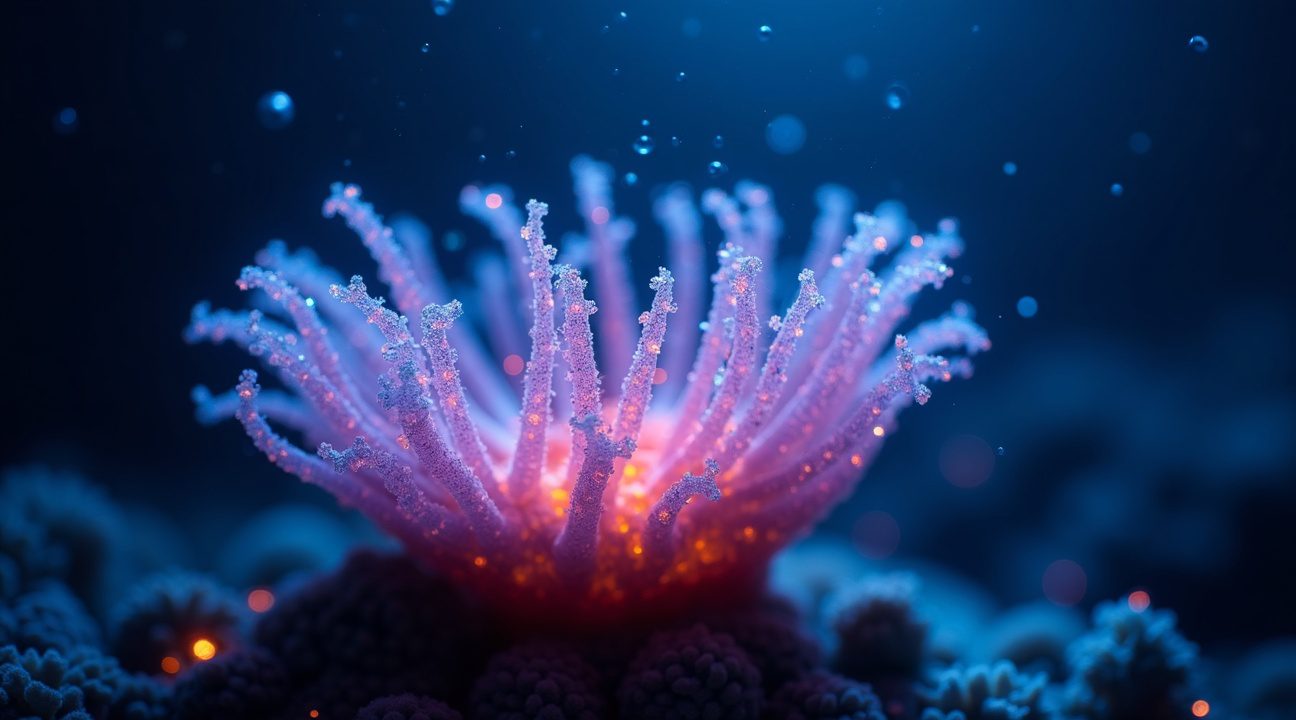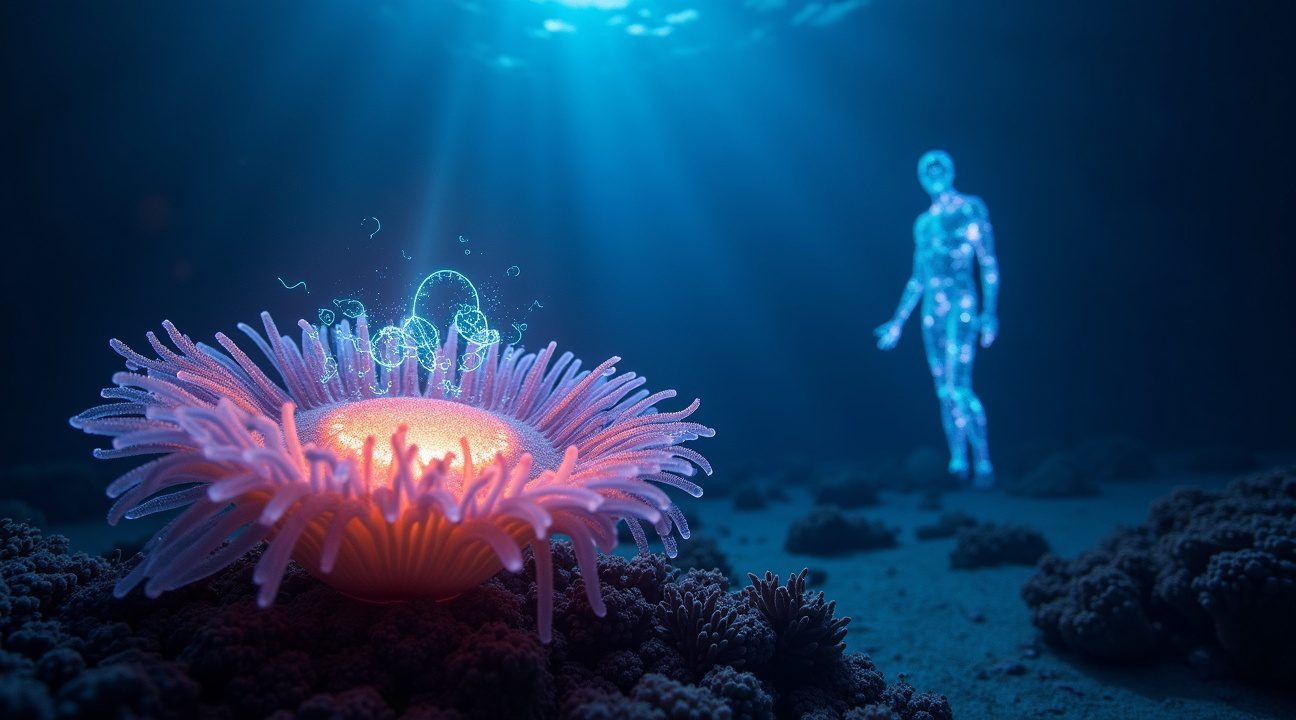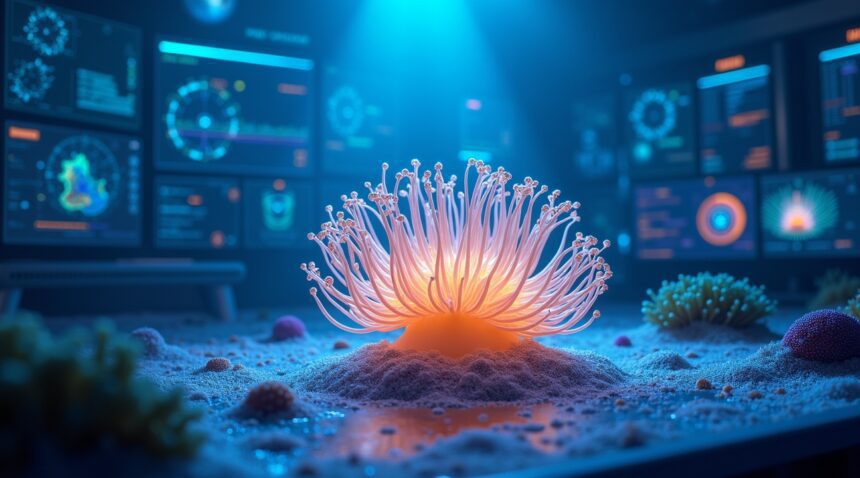Scientists at the University of Vienna have made a groundbreaking discovery by identifying multipotent stem cells in the starlet sea anemone, potentially unlocking the secrets to biological immortality and significantly advancing anti-aging research.
Key Takeaways
- Discovery of unique multipotent stem cells: Sea anemones contain previously unknown multipotent stem cells. These cells can differentiate into various cell types including nerve and glandular cells, enabling continuous tissue renewal without exhibiting any signs of aging.
- Ancient genes power regeneration and reproduction: These marine creatures utilize nanos and piwi genes — which are approximately 600 million years old — for both reproduction and regeneration. In humans, however, these genes are mostly limited to reproductive cell development.
- Stem cell longevity contrasts human aging: Unlike humans, who experience declining stem cell efficiency due to telomere shortening and cellular damage, sea anemones preserve a robust stem cell population throughout their life.
- Promising implications for human health: The findings could inspire therapies for degenerative diseases, lead to enhanced tissue repair methods, and potentially offer techniques for slowing the cellular aging process by mimicking sea anemone stem cell preservation.
- Why Nematostella vectensis was chosen: The starlet sea anemone’s dual reproductive strategies, extensively studied genome, and high ease of lab cultivation made it an optimal model organism for studying the foundations of biological immortality.
To explore more about this intriguing discovery, consider reading the detailed release from the University of Vienna.
Sea Anemones Show No Signs of Aging and Could Hold Keys to Immortality
Scientists have made a groundbreaking discovery that could change our understanding of aging and longevity. Researchers at the University of Vienna identified potential multipotent stem cells in the starlet sea anemone, known scientifically as Nematostella vectensis. This finding represents a significant breakthrough in biological research, as these marine creatures display remarkable characteristics that defy conventional aging processes.
The starlet sea anemone exhibits extraordinary biological properties that set it apart from most living organisms. These creatures show no signs of aging and possess the ability to reproduce asexually through a process called budding. This combination of traits makes them particularly intriguing subjects for studying immortality and cellular regeneration. The implications of this research extend far beyond marine biology, potentially offering insights into human aging and longevity.
Revolutionary Stem Cell Discovery
Andreas Denner from the University of Vienna led the cellular identification work that uncovered these previously unknown stem cells. The discovery proved challenging because these stem cells remained hidden due to their extremely small size, making them difficult to detect using traditional research methods. Scientists had to employ advanced techniques to finally identify and characterize these remarkable cells.
The research team utilized single-cell genomics methodology to identify the cells based on their specific transcriptome profiles. This sophisticated approach allowed researchers to examine individual cells and understand their unique genetic signatures. The study’s findings were published in the journal Science Advances, marking a significant milestone in stem cell research and aging studies.
Cellular Capabilities and Regenerative Potential
The identified stem cells demonstrate impressive versatility in their ability to differentiate into various cell types. These multipotent cells can form differentiated cells including nerve cells and glandular cells, showcasing their remarkable regenerative potential. This capability suggests that sea anemones possess a sophisticated cellular mechanism that maintains their tissues and organs indefinitely.
The discovery raises fascinating questions about the fundamental nature of aging and cellular death. While most organisms experience cellular deterioration over time, sea anemones appear to have evolved a system that continuously renews and repairs their biological structures. This process may hold crucial information for understanding how to combat aging in other organisms, including humans.
The research connects to broader scientific discussions about longevity and the possibility of biological immortality. Scientists continue exploring various biological phenomena that challenge our understanding of life and aging processes.
These findings open new avenues for research into regenerative medicine and anti-aging therapies. By studying how sea anemones maintain their cellular integrity without showing signs of aging, researchers may develop novel approaches to treating age-related diseases and extending healthy lifespan in humans. The stem cells’ ability to continuously produce differentiated cells while maintaining their own population represents a biological strategy that could inspire medical breakthroughs.
The research also highlights the importance of studying simple organisms to understand complex biological processes. Sea anemones, despite their relatively simple structure, possess sophisticated mechanisms that more complex organisms lack. This discovery demonstrates that immortality isn’t just a theoretical concept but an actual biological reality for certain species.
Future research will likely focus on understanding the molecular mechanisms that enable these stem cells to function without aging. Scientists will investigate the genetic and biochemical pathways that maintain these cells’ regenerative capacity and prevent the cellular damage typically associated with aging. This knowledge could eventually lead to therapeutic interventions that slow or reverse aging processes in humans and other organisms.

Ancient Genes Control Stem Cell Powers That Humans Only Use for Reproduction
Sea anemones possess remarkable regenerative abilities through specialized stem cells that express two ancient genes: nanos and piwi. These genes represent some of the most highly conserved genetic elements in the animal kingdom, maintaining their essential functions across hundreds of millions of years of evolution.
Universal Reproductive Genes With Extraordinary Powers
In virtually all animals, including humans, nanos and piwi genes enable the development of germ cells—the sperm and egg cells essential for reproduction. However, humans restrict the activity of these genes primarily to reproductive cell formation. Sea anemones have discovered a different application, utilizing these same genetic tools for continuous tissue regeneration and potentially achieving biological immortality.
The evolutionary timeline of these genes stretches back approximately 600 million years, demonstrating their fundamental importance to animal life. This ancient genetic machinery has remained remarkably stable throughout evolution, suggesting its critical role in basic biological processes.
CRISPR Experiments Reveal Gene Functions
Recent scientific investigations used CRISPR gene editing technology to understand how these genes function in sea anemones. Researchers employed molecular scissors to mutate the nanos2 gene specifically, creating controlled experiments to test its necessity for germ cell formation.
The results proved definitive—the nanos2 gene is absolutely required for germ cell development in sea anemones. When scientists disrupted this gene, the animals lost their ability to form reproductive cells, confirming its essential role in the reproductive process.
This finding illuminates a fascinating biological paradox: sea anemones use the same genetic toolkit for both reproduction and regeneration, while humans have specialized these genes exclusively for reproductive purposes. The research suggests that humans might possess latent regenerative capabilities locked within genes we currently use only for creating offspring.
The implications extend beyond simple cellular repair. Sea anemones demonstrate that ancient genetic programs can support both reproduction and tissue renewal simultaneously. This dual functionality raises intriguing questions about whether human regenerative medicine could benefit from understanding how these primitive animals maintain their remarkable biological capabilities.
The preservation of nanos and piwi genes across such vast evolutionary time periods indicates their fundamental importance to animal survival. While humans have refined these genes for reproductive specialization, sea anemones reveal alternative applications that could revolutionize our understanding of aging and cellular repair mechanisms.

How Stem Cell Decline Causes Human Aging While Sea Anemones Stay Forever Young
I’ve studied the fundamental truth behind human aging: we live as long as our stem cells. This principle explains why humans experience the gradual decline we call aging while sea anemones appear to sidestep this biological inevitability entirely.
Stem cells serve as the body’s repair crew, constantly generating new cells to replace worn-out tissue. In humans, these remarkable cells maintain our blood supply, refresh our skin, and even produce new hair follicles. They work tirelessly throughout our lives, but their capacity isn’t infinite. Over decades, their regenerative power weakens, their numbers dwindle, and their efficiency drops significantly.
The Molecular Signatures of Aging
Human aging carries distinct molecular fingerprints that scientists can detect and measure:
- Telomeres, the protective caps on our chromosomes, gradually shorten with each cell division until they can no longer protect genetic material effectively.
- Cells begin expressing senescence-associated beta-galactosidase (SA-β-gal), an enzyme that signals cellular aging.
- Cell cycle inhibitors like p16INK4a and p21 accumulate, essentially putting the brakes on cellular reproduction and renewal.
Sea anemones present a striking contrast to this aging profile. These marine creatures exhibit negligible senescence, showing virtually no signs of the typical aging process that affects humans and most other animals. Their molecular markers tell a completely different story:
- Telomere shortening occurs minimally.
- SA-β-gal expression remains low.
- The accumulation of cell cycle inhibitors that plague human cells simply doesn’t happen to the same degree.
The secret lies in their stem cell population. Sea anemones maintain robust pluripotent and multipotent stem cells throughout their lives. Pluripotent cells can develop into any cell type the organism needs, while multipotent cells can become several different types within specific tissue groups. This powerful combination enables sea anemones to regenerate damaged tissue with remarkable efficiency, sometimes even regrowing entire body parts.
Scientists studying these creatures have discovered that their regenerative mechanisms remain strong because their stem cells don’t experience the same decline that human stem cells face. Where human stem cells gradually lose their potency and become less responsive to signals for tissue repair, sea anemone stem cells maintain their youthful characteristics indefinitely.
This biological immortality doesn’t mean sea anemones are invulnerable – they can still die from predation, disease, or environmental catastrophes. However, they don’t appear to have an internal aging clock that inevitably leads to death through cellular deterioration.
The implications for human longevity research are profound. Understanding how sea anemones maintain their stem cell populations could reveal strategies for preserving human stem cell function longer. Some researchers believe this knowledge might lead to interventions that slow or even reverse certain aspects of human aging.
Current research focuses on identifying the specific mechanisms that protect sea anemone stem cells from the molecular damage that accumulates in human cells over time. These investigations might uncover ways to enhance human stem cell resilience or develop treatments that restore aging stem cells to more youthful states.
The contrast between human aging and sea anemone immortality illustrates how evolution has produced radically different approaches to cellular maintenance and repair. While humans evolved with built-in aging mechanisms that may have provided evolutionary advantages, sea anemones developed systems that prioritize indefinite cellular renewal. This comparison offers valuable insights that could potentially extend human healthspan and lifespan through targeted interventions in stem cell biology.
The study of these seemingly simple creatures continues to challenge our understanding of aging as an inevitable biological process, suggesting that immortality might not be as impossible as once believed.
What This Discovery Could Mean for Human Anti-Aging Treatments
This groundbreaking research opens remarkable possibilities for advancing human longevity science and age-related disease treatment. Scientists can now examine how genes maintain and regulate stem cells in sea anemones to potentially enhance stem cell longevity and regenerative capacities in humans.
The discovery identifies promising therapeutic targets for promoting tissue repair and extending human lifespan. I find it fascinating that these ancient marine creatures might hold keys to addressing some of humanity’s most persistent health challenges. The genes responsible for maintaining sea anemone stem cells could serve as blueprints for developing treatments that help human cells resist aging damage.
Potential Applications in Medicine
Future studies by Technau’s team will investigate which special properties of the sea anemone’s stem cells are responsible for its potential immortality. This research direction could yield several practical applications:
- Development of therapies to rejuvenate aging human stem cells
- Creation of treatments for degenerative diseases like Alzheimer’s and Parkinson’s
- Enhancement of natural tissue repair mechanisms following injury
- Improvement of organ transplant success rates through better cell preservation
- Design of interventions to slow cellular aging processes
Studying basal metazoans like sea anemones provides unique opportunities to uncover core principles governing stem cell maintenance and aging across species. These simple organisms represent early evolutionary stages, making them ideal models for understanding fundamental biological processes that persist throughout evolution.
The research explores conserved biological processes that may apply across species, suggesting that discoveries in sea anemones could translate directly to human applications. I believe this cross-species approach represents one of the most promising avenues for anti-aging research, as it focuses on universal mechanisms rather than species-specific adaptations.
Scientists have long searched for extraordinary biological phenomena that could revolutionize medicine, and sea anemone immortality appears to offer exactly that potential. The simplicity of these organisms makes them excellent research subjects while their complex regenerative abilities provide sophisticated blueprints for therapeutic development.
This discovery could accelerate the timeline for bringing effective anti-aging treatments to clinical trials. By understanding how sea anemones maintain their stem cells indefinitely, researchers can develop targeted interventions that address the root causes of human aging rather than merely treating its symptoms.
Why Scientists Choose This Tiny Sea Creature for Immortality Research
I’ve discovered that researchers consistently turn to Nematostella vectensis when investigating the biological mechanisms behind immortality. This small sea anemone has captured scientific attention due to its remarkable combination of practical laboratory advantages and extraordinary biological capabilities.
The species thrives remarkably well under controlled laboratory conditions, making it an ideal research subject. Scientists can maintain healthy colonies year-round without the complex environmental requirements that many marine organisms demand. This reliability allows researchers to conduct long-term studies essential for understanding regenerative processes and cellular behavior patterns.
Unique Reproductive Advantages
Nematostella vectensis offers researchers an exceptional dual reproductive strategy that proves invaluable for studying cellular renewal. The organism reproduces both sexually and asexually, providing scientists with multiple pathways to examine how genetic material transfers and how cellular regeneration occurs across generations.
Sexual reproduction allows researchers to study genetic variation and inheritance patterns, while asexual reproduction through budding reveals how the organism creates identical copies of itself. This budding process demonstrates the creature’s impressive regenerative capacity, as each new individual essentially represents a perfect cellular renewal event.
Advanced Biological Tools
The well-characterized genome of this sea anemone provides researchers with a complete genetic roadmap for their investigations. Having access to detailed genetic information accelerates research progress significantly, allowing scientists to identify specific genes responsible for regenerative abilities and cellular maintenance.
The organism’s exceptional tissue regeneration abilities extend far beyond simple wound healing. Nematostella vectensis can reconstruct entire body parts, maintain tissue integrity throughout its lifespan, and demonstrate cellular renewal processes that rival those found in theoretically immortal species.
Scientists have identified diverse stem cell populations throughout the organism’s body structure. These stem cell varieties each serve specific functions in maintaining tissue health and enabling regeneration. Some populations focus on digestive system renewal, while others concentrate on reproductive tissue maintenance or external body wall repair.
Cnidarians as a phylum represent some of the most ancient animal characteristics still present in modern biology. By studying Nematostella vectensis, researchers gain insights into fundamental biological processes that have remained largely unchanged for hundreds of millions of years. These ancient mechanisms may hold keys to understanding how cellular immortality functions at its most basic level.
The organism’s stem cell populations exhibit remarkable plasticity, meaning they can transform into various specialized cell types as needed. This flexibility allows the sea anemone to respond to different types of damage or cellular degradation by deploying appropriate regenerative responses.
Researchers have noted that the creature’s cellular maintenance systems operate continuously rather than responding only to specific triggers. This constant renewal process prevents the accumulation of cellular damage that typically leads to aging in other organisms. Stanford University research has explored similar concepts in examining how unusual biological phenomena might challenge conventional understanding.
Laboratory studies reveal that Nematostella vectensis maintains consistent cellular function across extended periods, showing no signs of the typical cellular degradation associated with aging. The organism’s ability to replace damaged cells with fresh, fully functional alternatives suggests biological mechanisms that could potentially be understood and applied to other species.
The combination of practical laboratory advantages and extraordinary biological capabilities makes this tiny sea anemone an unparalleled research subject. Its genetic accessibility, reproductive flexibility, and demonstrated immortal characteristics provide scientists with the tools needed to unlock fundamental questions about cellular renewal and biological immortality.
Sources:
Science Advances – “Nanos2 marks precursors of somatic lineages and is required for germline formation in the sea anemone Nematostella vectensis”
Technology Networks Cell Science – “Researchers Identify Potential Immortal Stem Cells in Sea Anemones”
GEN (Genetic Engineering & Biotechnology News) – “Anemone Stem Cells Make Waves in Anti-Aging Research”
World Health Net – “Potential Immortality: Stem Cells That Stay Young Forever”
Popular Mechanics – “How This Sea Creature Became Immortal—and How Humans Could”
Aging Pathobiology and Therapeutics journal – “Sea anemones as models for aging and regeneration research”
Stowers Institute for Medical Research – “Stinging starlet sea anemones”
AOL – “A Creature of the Sea Found the Secret to Immortality—and Humans”
NIH/PMC – “Nanos2 marks precursors of somatic lineages and is required”
The Niche (ipscell.com) – “Weekly reads: aging cells, scientists relying on ChatGPT, anemone”

